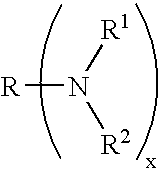Silver-containing inkjet ink
a technology of inkjet ink and silver salt, which is applied in the field of inkjet ink, can solve the problems of low silver content of silver ink, and achieve the effect of reducing silver salt to silver metal
- Summary
- Abstract
- Description
- Claims
- Application Information
AI Technical Summary
Benefits of technology
Problems solved by technology
Method used
Image
Examples
example 1
[0086] Silver ink 1A was printed with reducing ink 5A. Results, provided in the table below demonstrate that a highly conductive, smooth, mirror-like (“reflective”) silver film was produced.
SilverReducingResistanceInkInkAppearance2-pt4-ptComments1A5AReflective silver0.80.352Smooth andmirror-like
[0087] Optical and scanning electron microscopy (SEM) of the silver film showed smooth, uniform coverage of the patterned areas by silver metal. The metallic silver surface consisted of 200 nm-sized aggregates of 20 nm-sized silver particles.
example 2
[0088] The effect of reducing agent (formaldehyde) concentration and surfactant used in the reducing ink was tested by printing inks (5A, 5G, 5H, 5E, 5F and 5I) with silver ink 1A. Inks set 1A / 5A is a repeat run of the previous example.
[0089] The results, summarized in the following table, indicate that increasing formaldehyde ink concentration relative to silver ink concentration is detrimental to both the appearance and conductivity of the printed silver patterns. A 1.8 molar ratio of silver salt to reducing agent produced the best ink jet prints under the range of conditions explored. Also, ink with Zonyl® FS-62 gave less conductive prints than ink with Aerosol® OT or Surfynol® 465 surfactants. The Zonyl® ink (5I) did not appear to wet the media surface as well as the other inks, therefore the drops did not overlap as well and a less uniform film was obtained.
SilverReducingResistanceInkInkAppearance2-pt4-ptComments1A5AReflective silver—0.434 1.9 M HCOH; Surfynol1A5GReflective ...
example 3
[0090] The silver concentration and the reducing agent concentration were increased (relative to inks 1A / 5A in Example 1). The results, summarized in the following table, show that the ink set 1B / 5C in this example gave a significantly better sheet resistance than the 1A / 5A ink set of Example 1. Higher concentration of silver is advantageous for deposition of a thicker, more conductive printed silver film for the same number of layers printed.
SilverReducingResistanceInkInkAppearance2-pt4-ptComments1B5CReflective silver—0.09133 wt % silver
PUM
| Property | Measurement | Unit |
|---|---|---|
| surface tension | aaaaa | aaaaa |
| resistance | aaaaa | aaaaa |
| surface tension | aaaaa | aaaaa |
Abstract
Description
Claims
Application Information
 Login to View More
Login to View More - R&D
- Intellectual Property
- Life Sciences
- Materials
- Tech Scout
- Unparalleled Data Quality
- Higher Quality Content
- 60% Fewer Hallucinations
Browse by: Latest US Patents, China's latest patents, Technical Efficacy Thesaurus, Application Domain, Technology Topic, Popular Technical Reports.
© 2025 PatSnap. All rights reserved.Legal|Privacy policy|Modern Slavery Act Transparency Statement|Sitemap|About US| Contact US: help@patsnap.com



